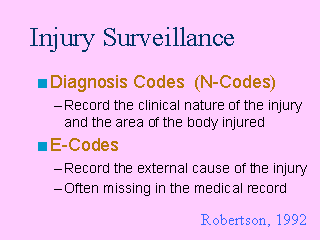|
|
|
|
front |1 |2 |3 |4 |5 |6 |7 |8 |9 |10 |11 |12 |13 |14 |15 |16 |17 |18 |19 |20 |21 |22 |23 |24 |review |
 |
Injury monitoring, just like other forms of monitoring systems,
is full of potential problems and biases. The classic monitoring
system is that based upon death certificates. It is usually
possible to identify most of the events because of laws requiring
registration of deaths, and because the endpoint is quite severe.
Monitoring systems for morbidity, including injuries, encounter more difficulties. It may be impossible to identify all events, population data may be hard to identify, and methods for monitoring events may change over time leading to better or worse identification of events). Most surveillance systems for injuries are based upon contact with the health care system. Injuries are usually defined in medical records by ICD-9 codes. Two types of codes are of most interest; N-codes (nature of injury codes) which identify the anatomy involved in the injury, and E-codes (external cause of injury codes) which identify the events leading to the injury. One major issue of concern for injuries, is that monitoring systems based upon medical records do not always provide details of the cause for the injury (E-codes). |
|
|
|
|
front |1 |2 |3 |4 |5 |6 |7 |8 |9 |10 |11 |12 |13 |14 |15 |16 |17 |18 |19 |20 |21 |22 |23 |24 |review |